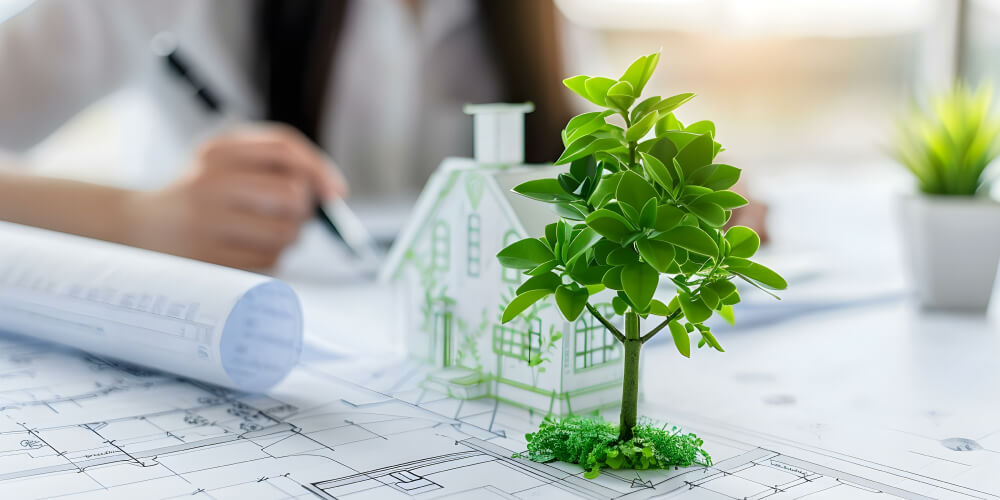1. Improve Energy Efficiency
Upgrade Insulation:
- Attic and Walls: Proper insulation in the attic and walls helps maintain indoor temperatures, reducing the need for heating and cooling.
- Basements and Crawl Spaces: Insulating basements and crawl spaces can prevent heat loss and improve overall energy efficiency.
Seal Air Leaks:
- Windows and Doors: Use weatherstripping and caulk to seal gaps around windows and doors, preventing drafts and energy loss.
- Ductwork: Seal and insulate ductwork to ensure efficient airflow and reduce energy waste.
Install Energy-Efficient Windows and Doors:
- Double or Triple Glazing: Choose windows with double or triple glazing to reduce heat transfer.
- Low-E Coatings: Select windows with low-emissivity (Low-E) coatings to reflect heat and improve insulation.
2. Use Renewable Energy Sources
Solar Panels:
- Solar Power: Install solar panels to generate electricity from the sun, reducing reliance on fossil fuels.
- Incentives and Rebates: Take advantage of federal, state, and local incentives to offset the cost of solar panel installation.
Wind Turbines:
- Small Wind Systems: In suitable locations, small wind turbines can generate renewable energy for your home.
- Hybrid Systems: Combine wind and solar power for a more reliable and consistent energy supply.
Geothermal Systems:
- Ground Source Heat Pumps: Use geothermal systems to heat and cool your home by tapping into the stable temperatures below the earth’s surface.
Join HICP Homeowner’s Alliance
Connect with experts, get special discounts and enjoy member benefits
3. Optimize Heating and Cooling
Upgrade HVAC Systems:
- Energy-Efficient Models: Replace old heating and cooling systems with energy-efficient models that use less energy to maintain comfort.
- Smart Thermostats: Install a smart thermostat to optimize temperature settings based on your schedule and preferences, reducing energy consumption.
Regular Maintenance:
- HVAC Maintenance: Schedule regular maintenance for your heating and cooling systems to ensure they operate efficiently.
- Filter Replacement: Replace air filters regularly to maintain good airflow and system performance.
4. Reduce Water Consumption
Install Low-Flow Fixtures:
- Faucets and Showerheads: Use low-flow faucets and showerheads to reduce water usage without sacrificing performance.
- Toilets: Install low-flow or dual-flush toilets to minimize water consumption.
Use Water-Efficient Appliances:
- Washing Machines: Choose ENERGY STAR-rated washing machines that use less water and energy.
- Dishwashers: Opt for water-efficient dishwashers that minimize water usage while maintaining cleaning performance.
Rainwater Harvesting:
- Rain Barrels: Collect rainwater from your roof to use for irrigation and other non-potable purposes.
- Greywater Systems: Install greywater recycling systems to reuse water from sinks, showers, and laundry for landscape irrigation.
5. Choose Sustainable Building Materials
Recycled and Reclaimed Materials:
- Reclaimed Wood: Use reclaimed wood for flooring, cabinetry, and other construction projects to reduce the demand for new timber.
- Recycled Metal and Glass: Incorporate recycled metal and glass into your home design to minimize waste.
Sustainable Resources:
- Bamboo and Cork: Choose rapidly renewable materials like bamboo and cork for flooring and furniture.
- Eco-Friendly Insulation: Use sustainable insulation materials like cellulose, wool, or recycled denim.
6. Implement Smart Home Technology
Smart Lighting:
- LED Bulbs: Replace traditional incandescent bulbs with energy-efficient LED bulbs.
- Smart Controls: Use smart lighting controls, such as dimmers and motion sensors, to optimize lighting use and reduce energy consumption.
Energy Monitoring:
- Smart Meters: Install smart meters to track your home’s energy usage in real-time and identify areas for improvement.
- Home Energy Management Systems: Use energy management systems to control and optimize the use of various home appliances and systems.
7. Adopt Sustainable Lifestyle Practices
Reduce, Reuse, Recycle:
- Waste Reduction: Minimize waste by reducing consumption, reusing items, and recycling materials whenever possible.
- Composting: Start a composting system for organic waste to reduce landfill contributions and create nutrient-rich soil for your garden.
Sustainable Transportation:
- Electric Vehicles: Consider purchasing an electric vehicle (EV) to reduce carbon emissions from transportation.
- Public Transport and Carpooling: Use public transportation, carpool, or bike whenever possible to decrease your carbon footprint.
Eco-Friendly Habits:
- Energy Conservation: Turn off lights, electronics, and appliances when not in use to conserve energy.
- Water Conservation: Be mindful of water usage by taking shorter showers, fixing leaks promptly, and using water-efficient practices.
Reducing your home’s carbon footprint is a vital step towards a more sustainable future. By improving energy efficiency, using renewable energy sources, optimizing heating and cooling, reducing water consumption, choosing sustainable building materials, implementing smart home technology, and adopting eco-friendly lifestyle practices, you can make a significant impact. Embrace these strategies to create a greener, more energy-efficient home that benefits both the environment and your wallet.




















